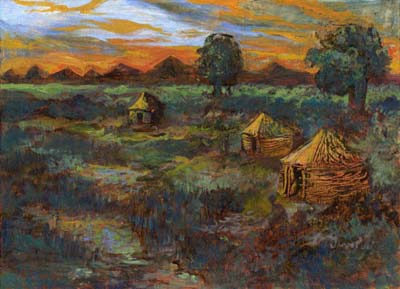Newly arrived peoples at Roman borders
(2nd-3rd century)
In the explored area of “Stari Vinogradi” around 60 structures have been found so far belonging to the 2nd-3rd century AD. Apart from two almost square houses — semi-dugouts, slide 60 with technical drawing and animation, slide 61, with dimensions of 3 х 3 m, having a central pillar as a roof support, several dugouts of almost square bases have also been explored, with rounded corners, irregular sides the length of 3 to 4 m and an uneven floor, as well as an oval, more deeply embedded dugout with an uneven floor. The remaining structures are storage pits slide 62, 63 of various shapes and sizes.
Among the pottery in these structures sherds of Roman pottery are found in larger quantities than before. Apart from a terra sigillata photo 82 there are amphorae photo 83, jugs photo 84, coated with an orange or red, sometimes metallic layer photo 85. There is an exceptional find of a piece of a bowl photo 86 with relief medallions, made on a swift wheel and later finished by imprinting in a mold. The medallions are filled out with figural depictions from Greek and Roman mythology, on which there is a separate study.
Local pottery mostly consists of deeper pots photo 87 and more rarely shallow ones photo 88 made by kneading, with the addition of coarse fire-clay. A large sieve was made in the same manner photo 89 and could have served for the draining of cheese or some similar task. Rare examples of gray polished dishes, made on a swift wheel, consisting of a small pitcher photo 90 and an amphora photo 91 , might also have been brought from the territory of the Empire, or possibly manufactured independently, as was done later, during the 4th century.
The Roman pottery, by analogies from Srem, can be dated to the 2nd and 3rd centuries. Imitations of terra sigillata rely upon originals from workshops in Westerndorf, from the end of the 2nd and the first half of the 3rd century, as well as in Reinzabern, from the 1st half of the 3rd century.
Apart from pottery, in the structures from this period tokens were also found photo 92, made as in the previous period from pottery sherds, disks photo 93, bronze fibulae photo 94 and bracelets photo 95. Both shown fibulae – legionary and Т-fibula with a spring – come from the same structure and can, according to analogous objects and other finds from this structure, be dated to the 3rd century. Among the few remaining finds we have whetstones photo 96, bone semi-finished products photo 97, text clay for pottery baking photo 98, as well as an amulet photo 99 made of the claw of some animal.
This is the age of the existence of the Roman province of Dacia, as well as of the grouping of barbarians of various origin at its outskirts map 3.

